Flaman Rentals Blog
RSS feed
Categories
Recent activity
- What's it like being a Flaman Rental Dealer?
- A Brief History of the Newest Flaman Store in Swift Current
- Disney's NEW Leadership Excellence Training Course
- Disney's Approach To Quality Service
- Disney's Approach To Quality Service
- Trailering 'Rules of the Road' Updated
- 10th Annual Frank J. Flaman Foundation Gala 2016
- Why Frank Cares
Authors
Archive
A Quick Response Solution to Combine Fires
Posted by Jeff Brown Jan 11, 2024
.jpg)
Quick Response Fire Suppression Skid
Combine fires can start in a fraction of a second and burn for up to 30 minutes before they’re noticed, damaging farm livelihoods, and economies. “It seems like every trade show I'm at, every customer I talk to knows somebody who’s had a fire on a combine,” says Ryan Flaman, at Flaman Group of Companies. “All it takes is one bearing to heat up, and those bearings are usually covered in dust or have dust all around.” Combines are often destroyed before a fire truck can arrive, adding callout costs of up to $10K.
Inspiration
Ryan focused on two words, “quick response.”
He sought to improve on the idea of mounting a quick response unit on the combine’s mobile shadow, the grain cart. Flaman already sold tanks, pumps, hoses, and other components they would need. Early in December, 2022, Ryan started envisioning fire protection that was more effective, comprehensive, affordable and accessible than what farmers could rig for themselves. Their input would prove invaluable.
.jpg)
Built-in fork pockets allow you to move the 48” wide skid to your half-ton truck or grain cart easily.
Finding the Right Components
Ryan studied available options and reviewed them in meetings with the Parts and Hardware department throughout the winter. There were units powered by rechargeable 12-volt batteries. Other small electric units offered a 35-gallon tank. Gas-powered kits offered 60 US gallon tanks and either mounted on grain carts or sat in the back of an RV or pickup truck. But many farmers were asking for more spray volume.
.jpg) A 150-gallon tank that fits neatly out of the way on a grain cart.
A 150-gallon tank that fits neatly out of the way on a grain cart.
Unfortunately, 250-gallon tanks took up too much space and weighed up to 3000 pounds with the necessary mounting hardware. The customers he talked to had their own number in mind – 150 Imperial gallons or 180 US gallons. The closest Ryan could source were 125 gallon tanks.
That tank was part of a prototype Ryan showed to his uncle Don Flaman. Don was excited, but Parts and Hardware thought they could come closer to the volume customers had asked for. So, they had a tank molded that could hold 150 gallons and fit neatly out of the way on a grain cart. It’s a uniquely Flaman component, unavailable any place else.
The skid plate was a slightly different story. Ryan had envisioned a hanger system to hold the unit from the top, but he needed a strong plate underneath that could support everything and be compact enough to fit in a tight space. This would also make it easy to transport and store. He scribbled the dimensions on a napkin diagram, scanned it, and sent it off to an engineer. That began a process of back-and-forth tweaks, honing a skid plate that met all the necessary criteria.
.jpg)
3/16” powder-coated steel skid. Ruggedly built to handle heavy use.
The final skid plate uses 3/16” thick metal, protected by Powdercoat. Similar products settled for a 1/16” thickness can be squished even flatter when the bolts are tightened. The Flaman skid also features fork pockets, so it can be easily moved to your grain cart, the back of a pickup truck, or any storage space when not in use.
.jpg) Cost-effective, reliable, and user friendly cartridge based foam delivery system.
Cost-effective, reliable, and user friendly cartridge based foam delivery system.
Fire Suppression
Next, Ryan and the team looked at fire-suppression foam. Direct-injection liquid foam systems seemed promising. Their foam mixing system was ideal for several home applications, but was it right for Flaman’s new firefighting unit?
Liquid foam has a limited shelf life, and it requires agitation once a month. With harvest coming once in a busy farm year, it was easy to forget the monthly maintenance. Ryan didn’t want his customers depending on something that had any chance of failing them at the exact wrong moment.
So, he opted for a solid foam cartridge system that restricts water flow. This creates more back pressure, so the stream can spray farther and hit flames harder. The cartridges don’t require shaking or have a predetermined expiry date. You can keep them in your pickup’s glove box until you need one.
.jpg) 100 feet of 3/4 inch 150 PSI hose on an industrial cox reel
100 feet of 3/4 inch 150 PSI hose on an industrial cox reel
Reliable Hose Access
Other firefighting units Ryan has seen have opted for clear air seeder (PVC) hose looped around two small hooks, which looked likely to tangle up at the worst possible moment. The Flaman Firefighter uses a black rubber hose rated at 150 PSI and spooled around a trusty Cox hose reel. Ryan chose it because it was compact, well-built and able to hold 100 feet of hose – putting plenty of reach in a small space.
.jpg) 2” Aluminum Pump with Honda GX200
2” Aluminum Pump with Honda GX200
The Pump for the Job
“The only thing that we readily had in stock was the pump,” Ryan says. The popular BE WP-2065HL general purpose water pump was ideally suited to the job. Equipped with a cast-iron impeller, it’s lightweight. Powered by a Honda GX200 Engine, it has the power to go all day every day.
But will it work?
After a winter of planning and assembling all the components, the team took the prototype out for field testing. To everyone’s gratification, there was no need to adjust its operation.
“We took the prototype number one and filled it up with water and throttled it up and water would shoot like 30 feet,” Ryan says. That’s some heavy pressure, but you’ll have a good 20 minutes of continuous flow without draining your tank, thanks to constriction at the nozzle.
The only necessary changes were to the tank's shape and the width of the skid. Those alterations made, the Flaman Firefighter was ready to report for duty – or more correctly, duties.
.jpg) Built-in fork pockets
Built-in fork pockets
More Uses than One
The Firefighter may be designed for combine fires, but its quick response capabilities lend themselves to other emergency applications, like grass and brush fires. Mounted on the back of a pickup truck, it can provide a first line of defense for more remote communities.
Value for Money
“I looked at what customers could get and what they would have to pay for it,” Ryan says. “I figured we could give them something better at a more affordable price.” That took a lot of planning, shopping around and testing, but the end product delivered the safety and functionality the customers wanted at the right size and price.
“Our customers’ feedback identified the issues we needed to address. They asked us to deliver a bigger tank, a heavier skid, a pump with a bigger motor, and a hose reel that’s compact but still heavy-duty. They answered the question, ‘How can I make something better?’ I think I made more work for myself than I needed to, but I’ve enjoyed this.”
See the Future of Farm Firefighting at Your Nearest Flaman Location
The Flaman Quick Response Fire Suppression Skid is one of many farm, home and business safety solutions we offer. Drop by and see this Inhouse-designed unit at any of our seven Flaman Sales locations in Saskatchewan and Manitoba.
Call or visit your nearest location – Swift Current, Swan River, Prince Albert, Saskatoon, Southey, Yorkton, or Moosomin. Our fire suppression experts will be happy to show you the many features that could make all the difference one day.
Posted in Product Information | Tagged with Combine fires firefighting Quick Response Fire Suppression Skid | More articles by Jeff Brown
Be ready for harvest 2022: Summer is the time to build your bins & install your grain handling equipment
Posted by Calla Simpson Jun 24, 2022
Now that seeding is complete and the crops are growing, you may be starting to think about the next steps in your farming operation for 2022. This likely includes thoughts of additional Grain Storage, Grain Handling, and even Grain Drying equipment.
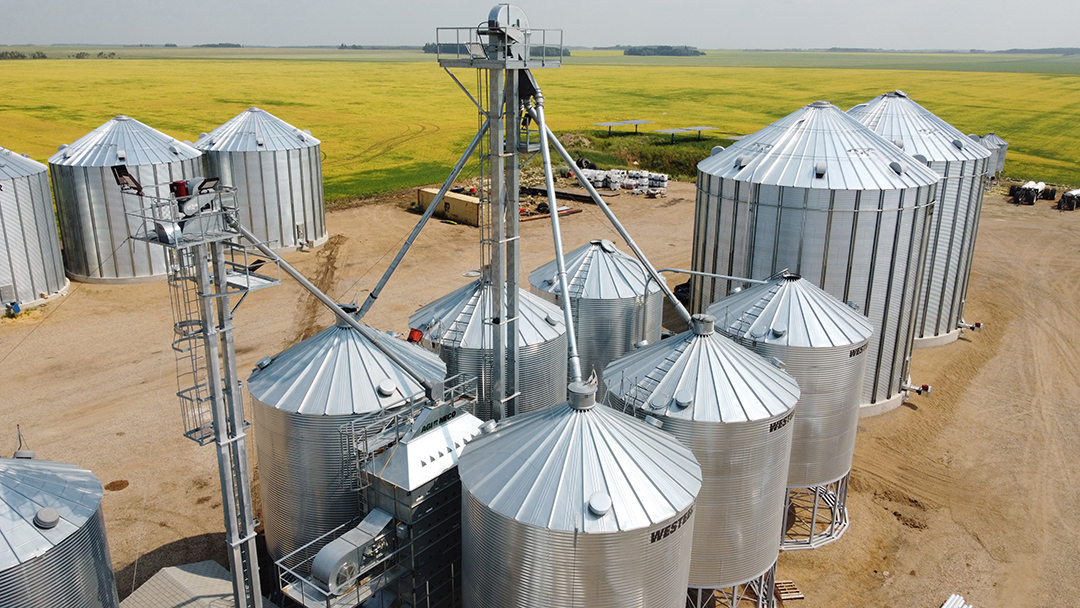
It may seem early to plan for harvest, but summer is a great time to build your bins and install your grain handling equipment to move the crop come harvest time. Buying now will ensure your equipment is installed and ready to go in the fall – so you can have peace of mind all season long.
Lean on the Pros
At Flaman, our Grain Systems team is equipped to work with you on developing your yard for the future. Let one of our industry experts come to your yard to measure, draw, and discuss your needs for the coming year. Our tactical approach provides you with various drawings and site layouts that can utilize your existing equipment, and plan for future expansion in a multi-phased strategy.
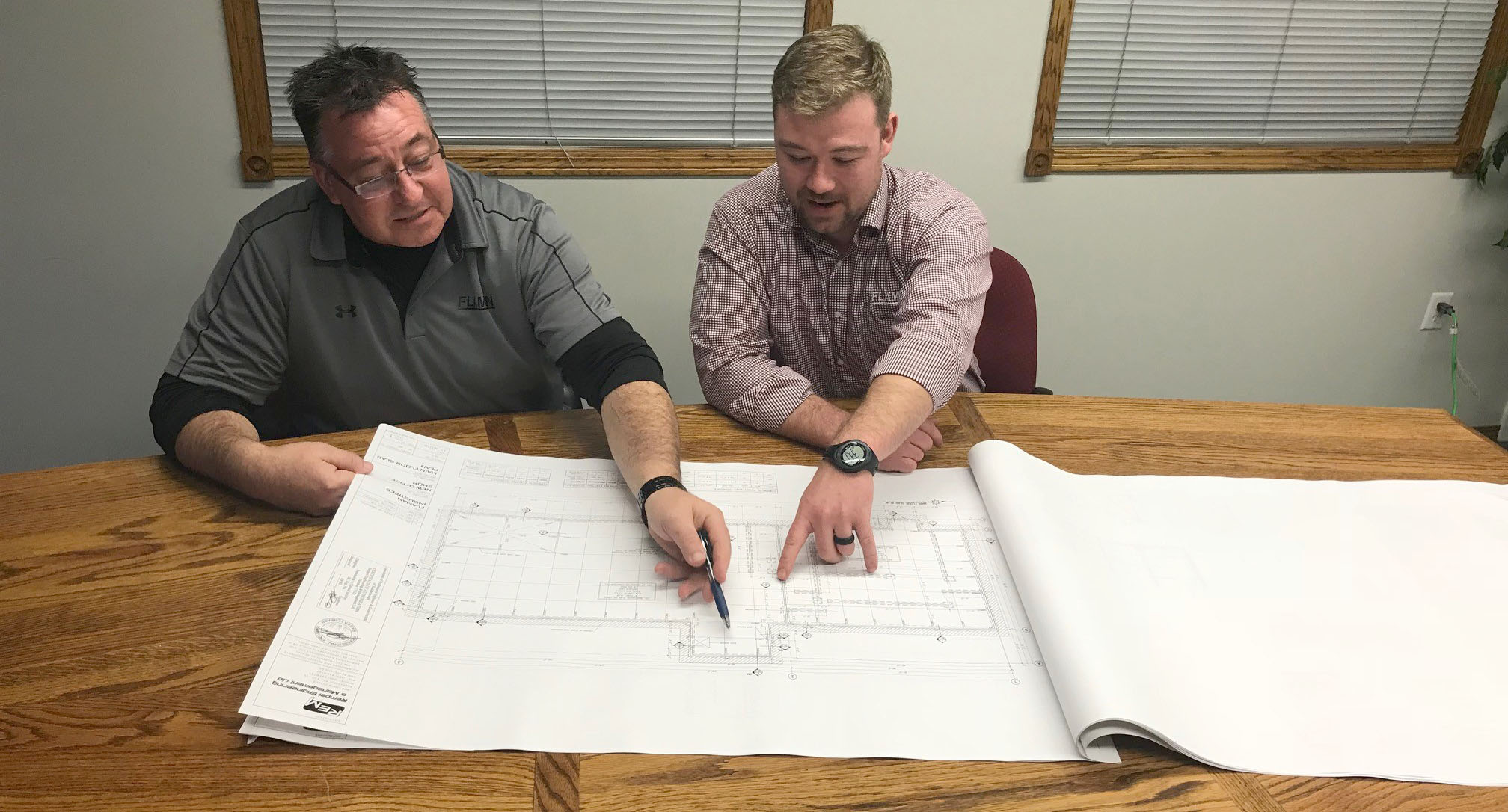
We can create a yard design based on your operational needs and the desired function of your site.
We specialize in full grain handling setups, including a wide range of bucket elevators and pneumatic conveyors – such as the Walinga Ultra-Veyor. Our turn-key offering also includes grain dryer systems, like the NECO Mixed Flow Dryer, as well as grain cleaning and processing facilities, automated bin sites, and producer loading sites.
Our team is here to guide the entire setup and installation process of your grain handling system and provide maintenance and service for every item that goes in and out of our doors.
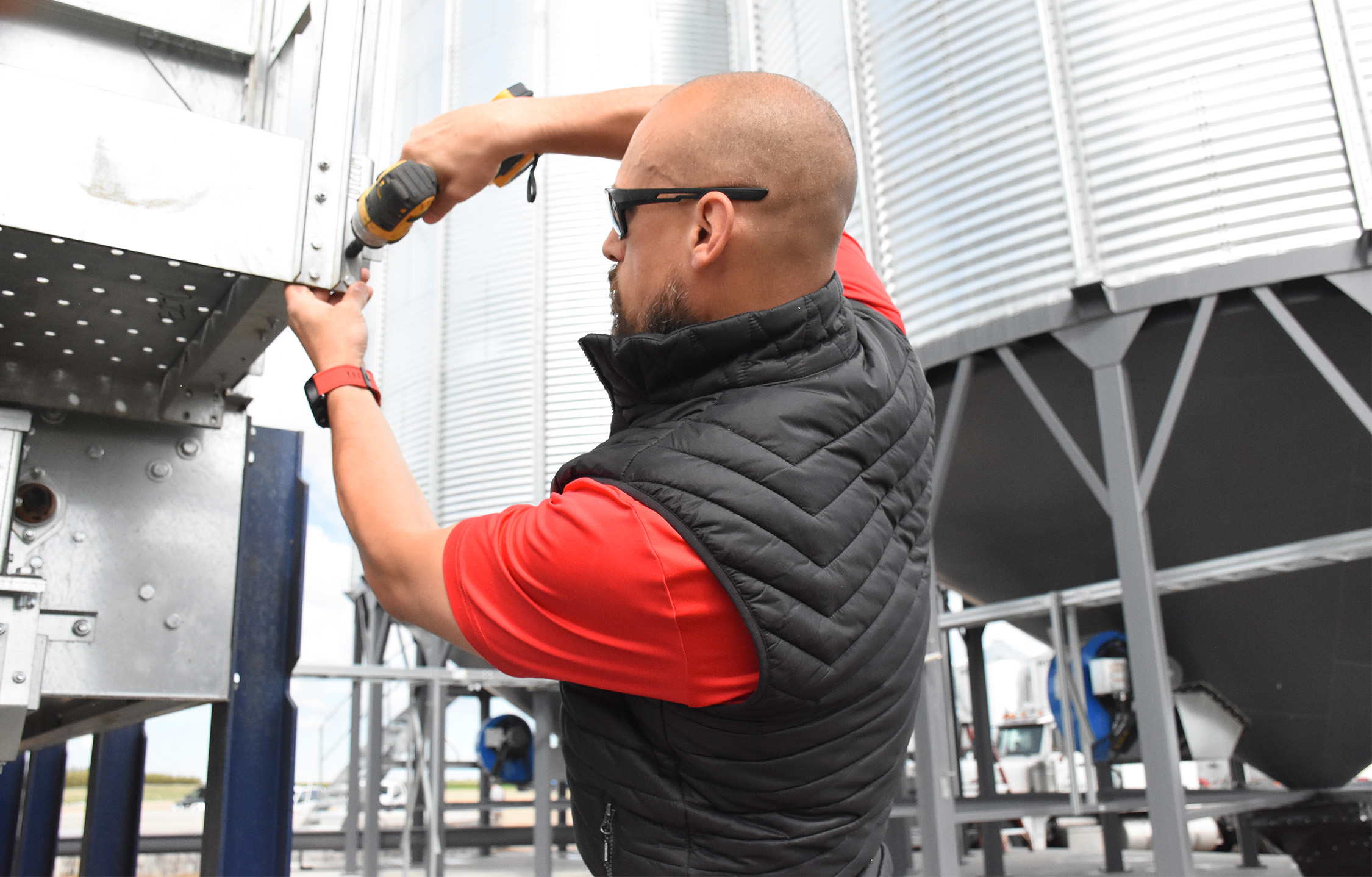
Schedule your appointment today for a free, no commitment site assessment.
-----
For more information on our grain handling and grain drying solutions, talk to one of our agriculture specialists at your nearest Flaman location.
Posted in Ag news | Tagged with grain systems grain handling grain drying grain cleaning turnkey bin site NECO Walinga | More articles by Calla Simpson
Need to move water? We have solutions
Posted by Calla Simpson Jun 11, 2021
With heavy rainfall in many areas across the prairies, you may be dealing with excess water on your farm, acreage, or worksite. Flooded ditches, construction sites, dugouts, or even just low-lying spots in your field can accumulate serious pools of water. Not to worry, though, we have a number of water pumps to help you move water quickly.
We have a large selection of water pumps ranging in size from 1” to 4” from brands like Honda, BE, and Robin. We also carry two brands of floating pumps: Watermaster and Warthog. The Watermaster floating pump is a high-volume, low horsepower pump, available in either gas-powered or hydraulic configurations. The Warthog floating pump is a highly fuel-efficient piece of equipment that is capable of pumping continuously up to 15 hours at 850 gallons per minute (51,000 gallons per hour) and is so compact it can fit in the trunk of a car.

From right to left: BE water pump, Warthog floating pump, Honda water pump
For your existing spraying or pumping operation, we have all the hoses, fittings, and filters you will need to keep things running smoothly.
We carry a variety of spraying and pumping hoses including lay-flat, air-seeder, and industrial-grade suction hoses at an affordable cost. They can be purchased pre-cut to a specific length, so you can have the option to build your own efficient system right off the shelf.
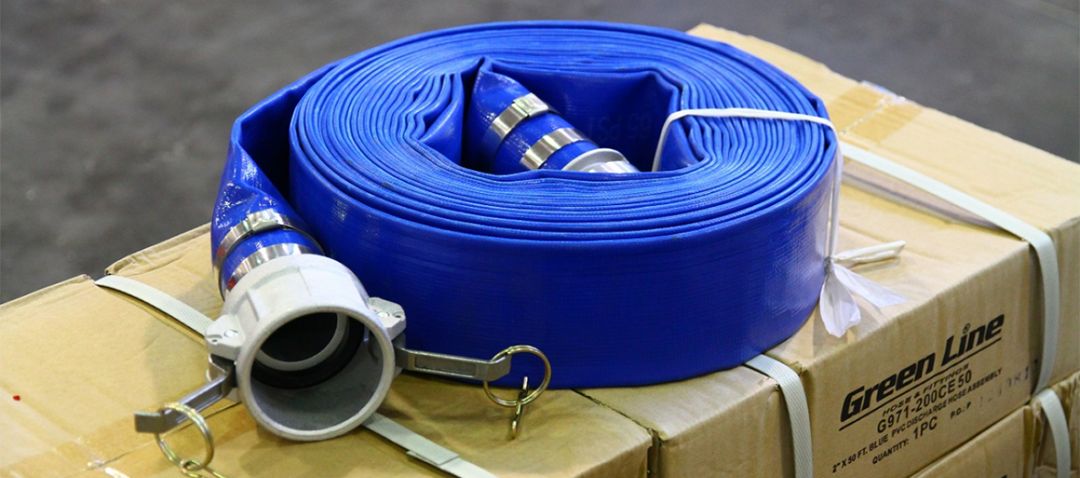
Our large selection of hose and pipe fittings are offered in both aluminum and plastic, with options for manifold or threaded style. We specialize in 1” to 4” size fittings that include cam locks, ball valves, reducers, pipe thread, flanges, and more.

We carry Super Flo water filters that are rated at over 4,000 gallons per hour and are equipped with easy-to-replace foam and mesh. If your pump to filter hook up needs some tweaking, we have adapters available for your convenience. We also carry filter floats at some of our locations, which are useful in removing some of the hurdles associated with pumping water – eliminating the need for waders and keeping your filter submerged in sloughs, ditches, ponds, and dugouts as low as 10” deep.
Filter Float demo video
-----
From water pumps, floating water pumps, filters, fittings, hoses, and accessories, Flaman is here to provide you with efficient, reliable, and cost-effective solutions to move water. To learn more about our selection of products or to get expert advice for all your water moving needs, talk to one of our team members at your nearest Flaman location.
Posted in Product Information | Tagged with water pumps filters fittings hoses Honda BE Robin Watermaster Warthog | More articles by Calla Simpson
A long-distance grain rescue made possible by Bin-Sense
Posted by Jennifer Thompson Oct 14, 2020
You can anticipate grain spoilage as a farmer, but you can never be sure when it’s going to pop up. Or where you’ll be when it does.And what happens if your grain starts to spoil or heat up and you’re nowhere near home, but thousands of kilometers away on a family vacation? That’s what happened to Blake Bergen of 3B Acres in Drake, SK in the fall of 2019 when his Florida vacation was interrupted by news that a canola bin was heating up.

He was getting alerts from his Bin-Sense Live wireless grain monitoring system, an award-winning monitoring system that gives you instant access to your stored grain at any time and from anywhere.
With this system, farmers no longer have to be in the same physical location as their hopper or flat bottom bins to monitor them. They can get valuable information about the grain's quality and stay connected with up-to-date text alerts sent to phone or email.
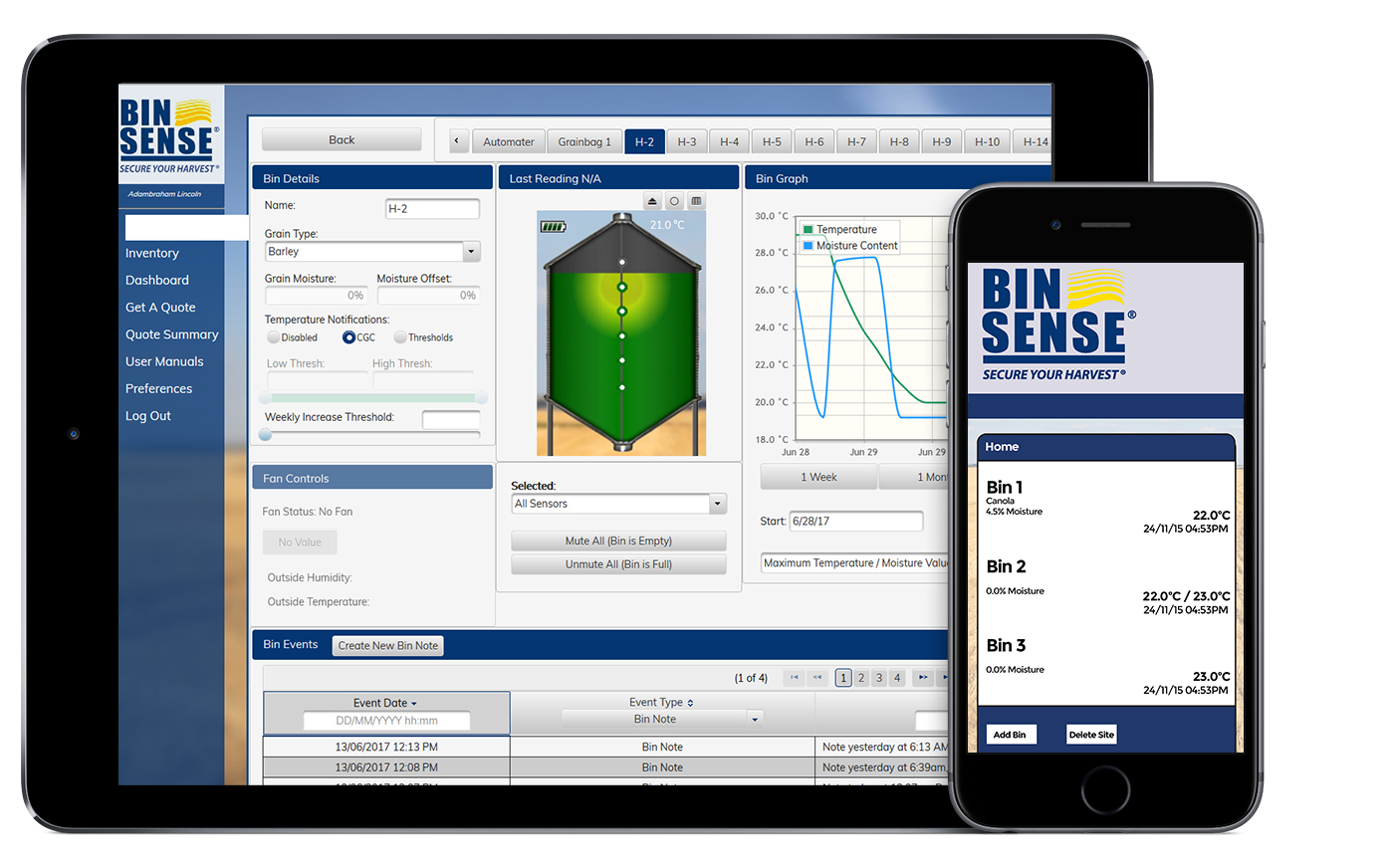
Those alerts warned Bergen about the situation in his bin, when he otherwise may never have known.
“That bin was not top-of-mind among riskier bins, said Bergen. “We thought we had that one well looked-after so it surprised us when we got the alert.”
Surprised, but not surprised. There were many factors that had led Bergen and his father to install Bin-Sense Live. They had witnessed a dry spring, which led to late crops in July. They also had questions about the storability of straight-cut canola. “We knew we were going to get some stagey canola coming in,” said Bergen. “It wasn’t going to necessarily be swathed at exactly the right time. There was potential for green seeds.”
The Bergens took the proactive approach through grain drying and monitoring. “We thought the odds of having something happen, just the way the crops were looking, were pretty good. We knew if we had a train-wreck, we’d buy a system so it wouldn’t happen again, so why not buy the system before the train-wreck and then it pays for itself?”
In summer 2019, Flaman installed a Live system. Moreover, among their 200,000 bu of monitored grain storage, they also have 42,000 bu worth of hopper bins connected to supplemental heat air drying with temperature and moisture cables monitored by Bin-Sense Live. But it was later that fall when Bin-Sense Live’s communicating technology became critical.
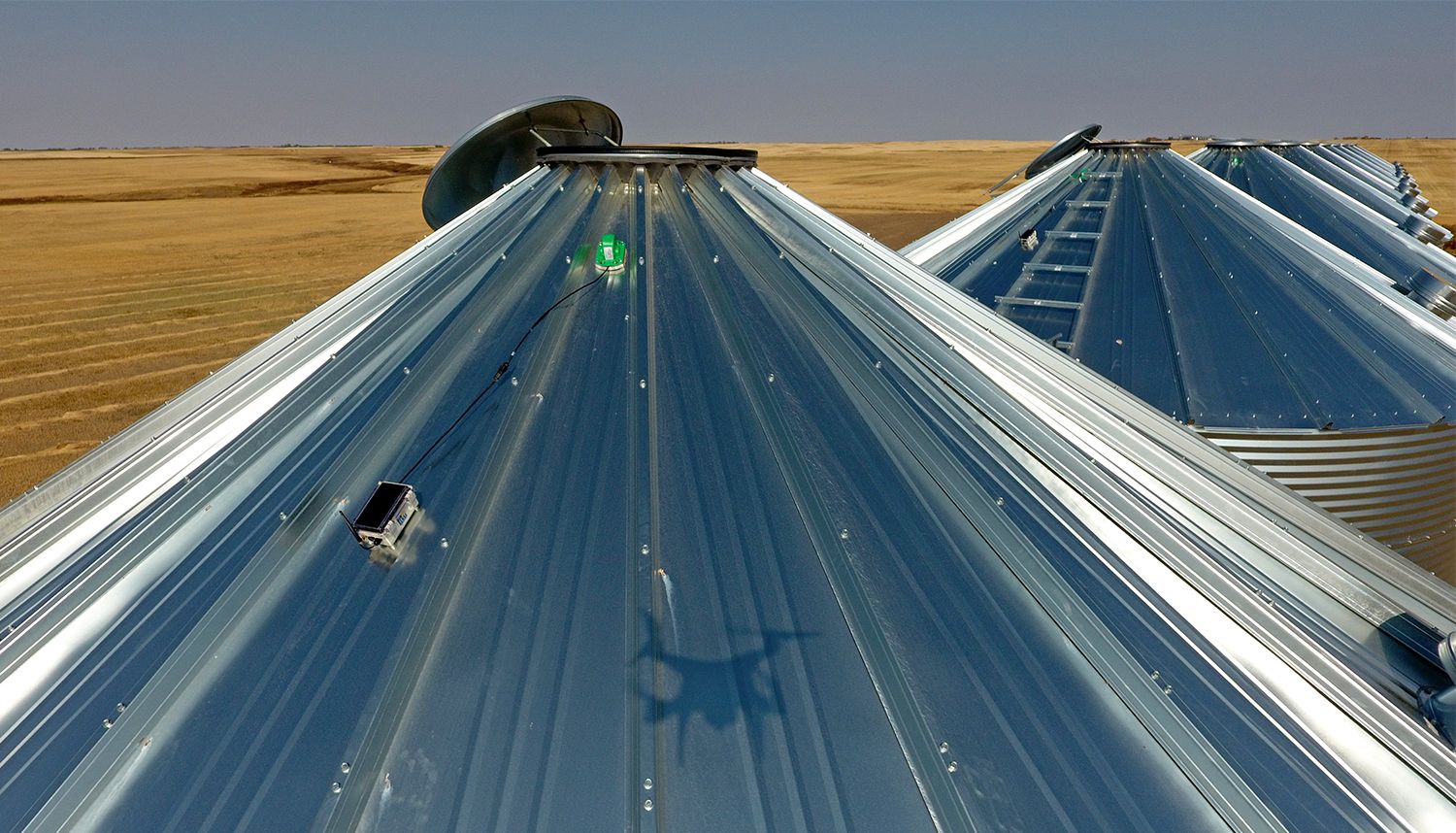
An example of Bin-Sense installed on a bin
“We were going on a two-week vacation to Florida with our extended family,” said Bergen. “On day 1 after landing, we got a chirp on our phone that a bin of canola that had increased in temperature. We decided to watch it for two or three days and could see a constant climb of 1 to 1.5 degrees every day. We phoned home and asked some friends to take a semi-load out of the bin. They took it to the elevator and we saved that bin of canola.”
Even though heat rose in the smallest of bins, the save justified the cost of monitoring the entire yard. “There are lots of misconceptions out there about spoilage and the size of bin,” said Bergen. “I look at grain monitoring as a solid return on investment,” noting that he paid upwards of $17,000 for the system. Saving 5,000 bu of canola, Bergen estimates Bin-Sense Live paid for itself twofold.
He doesn’t spend much time reconsidering the choice between Bin-Sense Live and systems where you check grain on foot. “You can hem and haw about the investment when you have the capability to check your bins manually, but you still have to make a point of doing it. We have 30 bins on the system so it’s more than a three-minute job. It’s a lot of plugging in and downloading. It’s nice to just bring everything up on your phone or your computer and read the colour-coded heatmaps. It’s quick to interpret and see what’s going on.”
So how to thank colleagues who have rescued valuable crops? Blake Bergen squared up, returning from Florida bearing gifts of fine imported bottles. Add the cost to the grain monitoring bill, and he still came out ahead.
Call your local Flaman dealership today to find out more about how Bin-Sense can make sense for your farm.
Posted in Product Information | Tagged with grain monitoring grain bins Bin Sense grain temperature | More articles by Jennifer Thompson
Tips and Resources for a Safe Harvest
Posted by Jennifer Thompson Aug 17, 2020
As harvest begins to start in many parts of Western Canada, Flaman is here to provide the tools and equipment you need to get your crop off quickly and safely. Along with our wide variety of Harvest Helpers to aid you in your work, we’ve collected some important and useful safety tips for harvest time. We want to make sure all our customers return safely from the field and have the resources to support their employees and family members on the farm.
This post will look at 4 main types of safety:
- Grain bin entrapment
- Fire safety and prevention
- Machinery and power lines
- COVID-19 safety
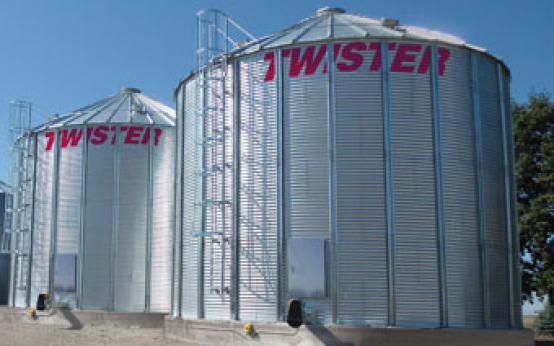
Grain Bin Entrapment
Tough grain is one of the leading causes for producers to enter a bin. Many studies have shown that entering a bin to break up spoiled grain while operating unloading equipment is the leading cause of grain entrapment. A person could become completely covered within 20 seconds. Across Canada, there’s an average of six fatalities every year from grain entrapment or engulfment.
If you need to enter a bin to asses grain, there is a Grain Bin Assessment chart from the Canadian Agricultural Safety Association you can use to assess if it’s safe to enter the bin.
This fact sheet from the Canadian Centre for Health and Safety in Agriculture also has some helpful information about how grain entrapment occurs, as well as preventative and safety measures.
And finally, if you wish to create a Confined Space Management Program for your farm, this quick start guide from Ag Safe Alberta is a useful tool. Along with grain bins, confined spaces also include sumps, wells, feed bins, attics and even some equipment.
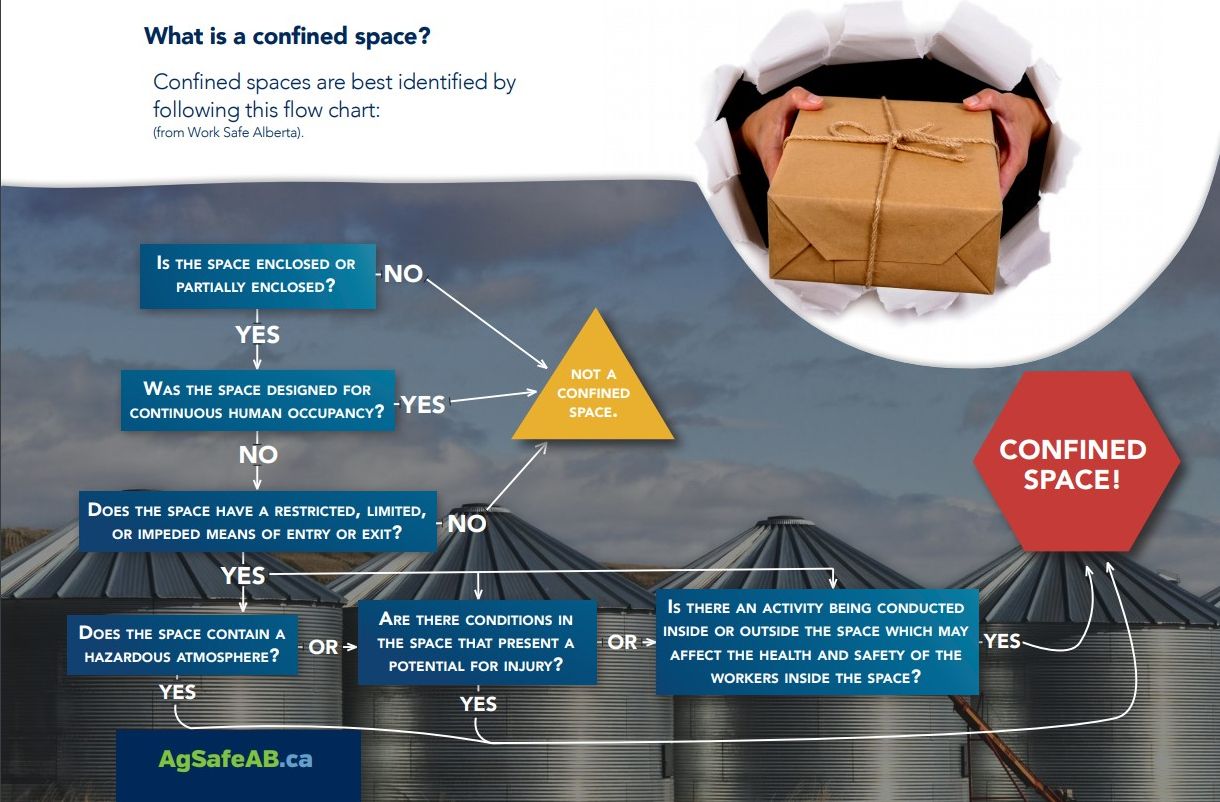
Fire Safety and Prevention
Fires in the field can happen all too suddenly when working with dry, flammable material and hot mufflers and electrical wiring. There are some simple pre-cautionary measures you can take to help avoid the risk of injury or loss of equipment due to fire.
- Have working fire extinguishers mounted on equipment, ideally one in the cab and one accessible from the ground. Alberta Agriculture recommends a 10 pound dry chemical, multi-purpose ABC extinguisher and a 2.5 gallon pressurized water extinguisher on combines.
- Remove crop residue, dust, debris, dirt and excess lubricant around all heat sources regularly. Check for a buildup of combustible crop residue around engines and exhaust systems, concealed drive belts and pulleys that can overheat due to friction.
- Be careful when using low clearance vehicles in fields, as exhaust pipes and catalytic converters can ignite dry grass or stubble.
- Check exposed wiring and fuel/hydraulic lines for damage, wear and deterioration.
- Allow engines to cool before refueling.
And for added safety, Flaman carries a variety of firefighting pump and tank units, such as the Enduraplas Fire Ranger or the BE Fire Cart, to allow you to quickly put out any fires in the field while harvesting.
Machinery and Power Lines
Electrical safety is another important area to be aware of when working with large machinery on a farm. More than 40% of agricultural workers in Canada have reported direct hits or near misses with power lines. In 2019, there were 326 farm safety incidents reported to Sask Power. The most common causes of electrocutions on the farm are portable grain augers, large combines, high clearance sprayers and other tall equipment that can come into contact with overhead power lines.
There are two types of electrical injury that can occur:
- Electric shock, when electric current passes through the body causing injury or death.
- Arc flashes: a blast of energy caused by an electric arc, which can produce sounds waves, extreme heat, shrapnel and more, This can lead to lung injuries, ruptured ear drums, burns, blindness or death.
This guide “Electrical Safety on Saskatchewan Farms" from Sask Power talks about potential risks and hazards and offers safety tips, guides and checklists to make sure you and your workers come home safe. Or you can print out this Farm Safety Checklist to make sure everyone knows how to avoid overhead lines and what to do if an accident occurs.

COVID-19 Safety
This year, farming operations will have the added tasks of protecting workers and their family from COVID-19. As an essential service, we recognize that farmers must continue to work to grow our food and feed our country.
Along with the general pre-cautions such as hand washing, physical distancing, cleaning of work attire and wearing gloves, this fact sheet from the Canadian Centre for Occupation Health and Safety offers many safety tips specifically for the agricultural industry in areas such as:
- Transportation
- Sanitation
- Group Living and Residence Recommendations
- Team and Site Management
- And much more.

For those interested in creating an overall safety plan for their operation, this workbook from Ag Safe Alberta lays out the steps to create your own Farm Safe Plan.
Posted in Ag news | Tagged with harvest safety farming grain bins electrical safety | More articles by Jennifer Thompson
Be ready for harvest 2020: Summer is the time to build your bins & install your grain handling equipment
Posted by Calla Simpson May 29, 2020
As seeding is coming to a close throughout the province, you may be starting to think about the next steps in your farming operation for 2020. This likely includes thoughts of additional Grain Storage, Grain Handling, and even Grain Drying equipment.
It may seem early to plan for harvest, but summer is a great time to build your bins and install your grain handling equipment to move the crop come harvest time. Buying now will ensure your equipment is installed and ready to go in the fall – so you can have peace of mind all season long.
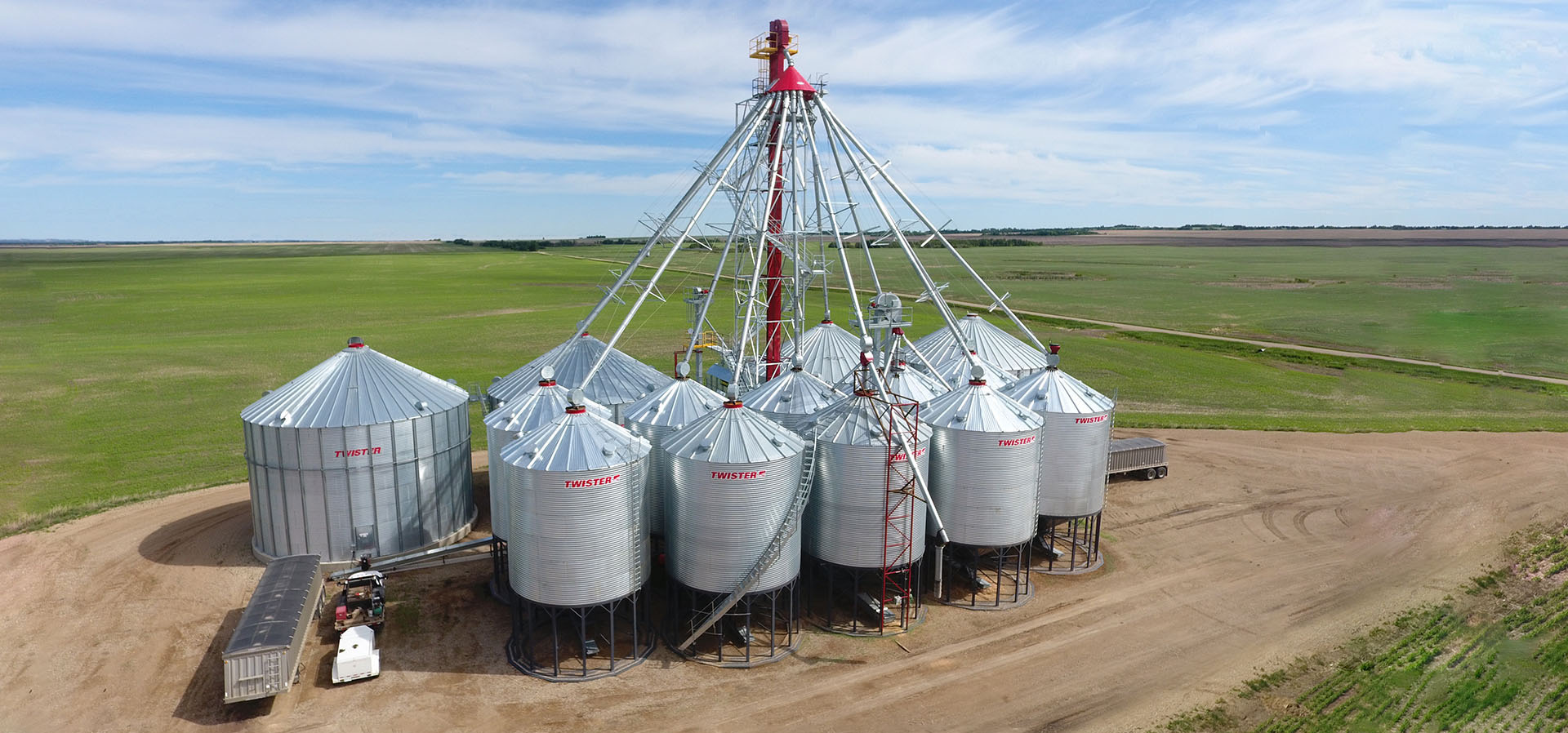
Lean on the Pros
At Flaman, our Grain Systems team is equipped to work with you on developing your yard for the future. Let one of our industry experts come to your yard to measure, draw, and discuss your needs for the coming year. Our tactical approach provides you with various drawings and site layouts that can utilize your existing equipment, and plan for future expansion in a multi-phased strategy.
 Our Specialists can create a yard design based on your operational needs and the desired function of your site.
Our Specialists can create a yard design based on your operational needs and the desired function of your site.
We specialize in full grain handling setups, including a wide range of bucket elevators and pneumatic conveyors – such as the Walinga Ultra-Veyor. Our turn-key offering also includes grain dryer systems, like the NECO Mixed Flow Dryer, as well as grain cleaning and processing facilities, automated bin sites, and producer loading sites. Our team is here to guide the entire setup and installation process of your grain handling system and provide maintenance and service for every item that goes in and out of our doors.

Schedule your appointment today for a free, no commitment site assessment.
-----
For more information on our grain handling and grain drying solutions, talk to one of our agriculture specialists at your nearest Flaman location.
Posted in Ag news | Tagged with grain systems grain handling grain drying grain cleaning turnkey bin site NECO Walinga | More articles by Calla Simpson
Chembine: Canadian-made chemical handling solutions
Posted by Calla Simpson May 04, 2020
We are excited to offer two new products in our Chem Handling lineup: the Chembine Chemical Mixer and the Chembine Hot-Tank.Designed and manufactured in Western Canada, the Chembine Chemical Mixer from Freeform Plastics is an innovative solution for batch mixing chemicals on your farm. With a capacity of 75 US gallons (62.5 imperial gallons), this tank saves you time and money with its faster drain time, new knife block design, and the latest innovation in agitation.
This new chemical mixer was also designed to be more user-friendly and ergonomic, so you won’t have to bend over as often to reach the valves – preventing unnecessary strain on your back.
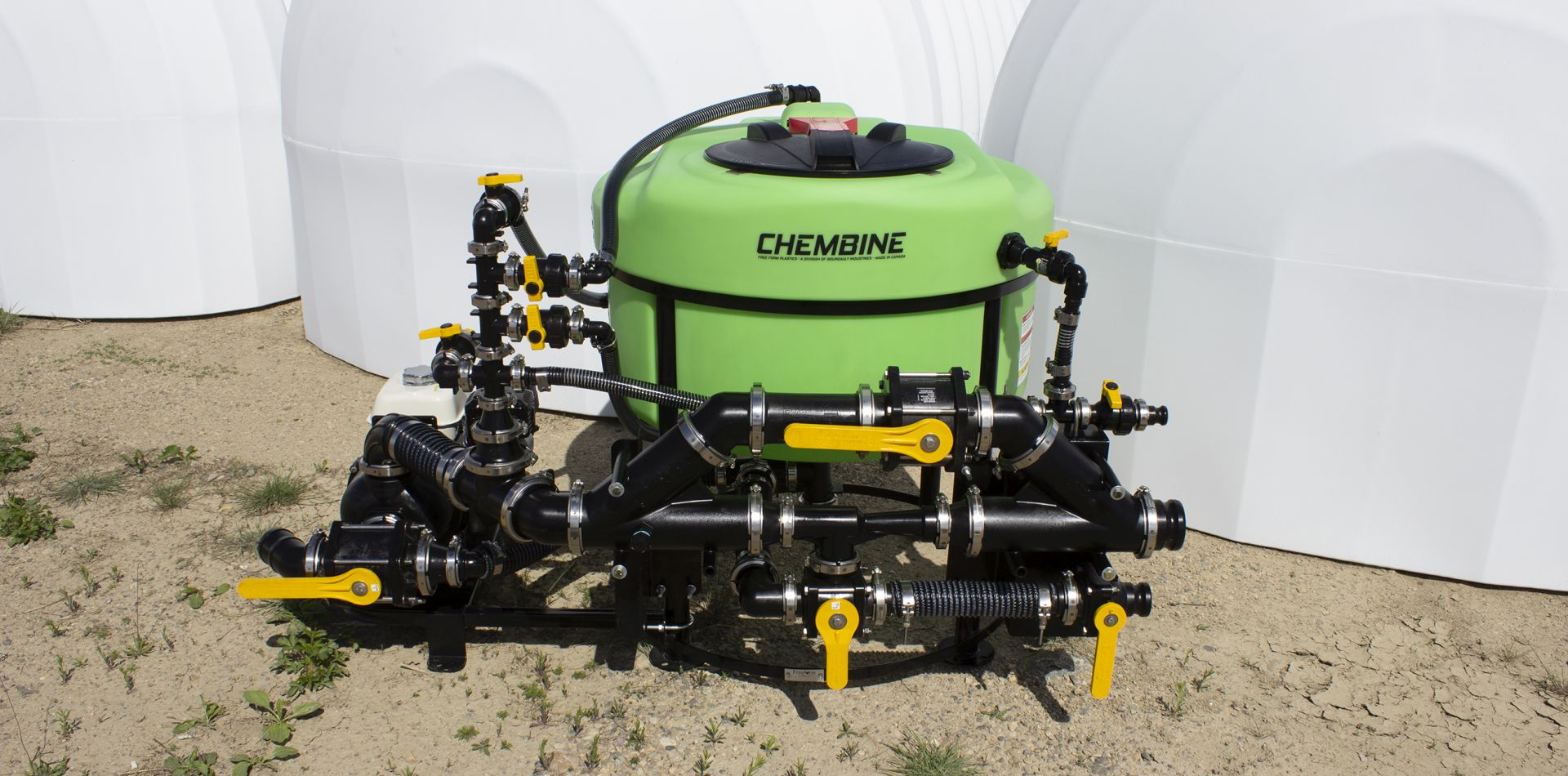
The Chembine is sold without a pump, however there are two optional pump kits available to create a complete system. The first option is a 6.5 HP Honda with a Wetseal Banjo pump, and the other option is a 13 HP electric start Honda with a Hypro pump.
To learn more about the features of the Chembine Chemical Mixer, check out this interview with Freeform Plastics:
The Chembine Hot-Tank is another beneficial product for your farm, as this high-capacity tank can hold up to 1680 US gallons (1400 imperial gallons) at once.
The Hot-Tank will agitate your chemical mix, so that it doesn’t separate. This will allow you to pre-mix your entire chemical load ahead of time, so when the sprayer arrives everything is prepped and ready to go.
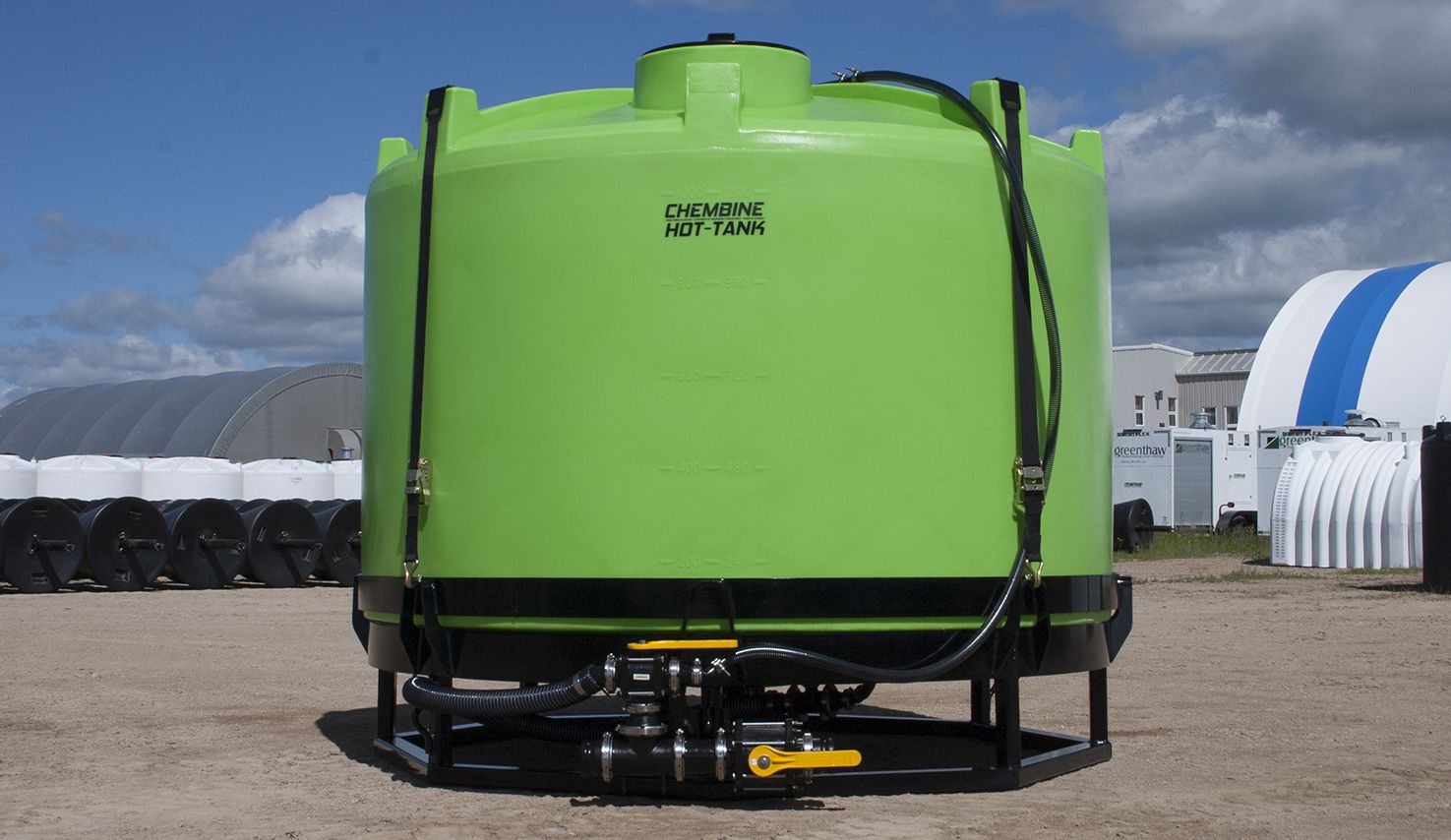
Instead of paying for the tank, the parts, and the labour separately, this convenient alternative comes plumbed up and ready to use – allowing you to spend more time mixing and spraying.
Justin walks through the features of the Chembine Hot-Tank
-----
For more information on these products and to view the rest of our Chem Handling solutions, click here.
Posted in Product Information | Tagged with Chembine chemical mixer chemical handling chem tank Hot-Tank | More articles by Calla Simpson

 Locations
Locations
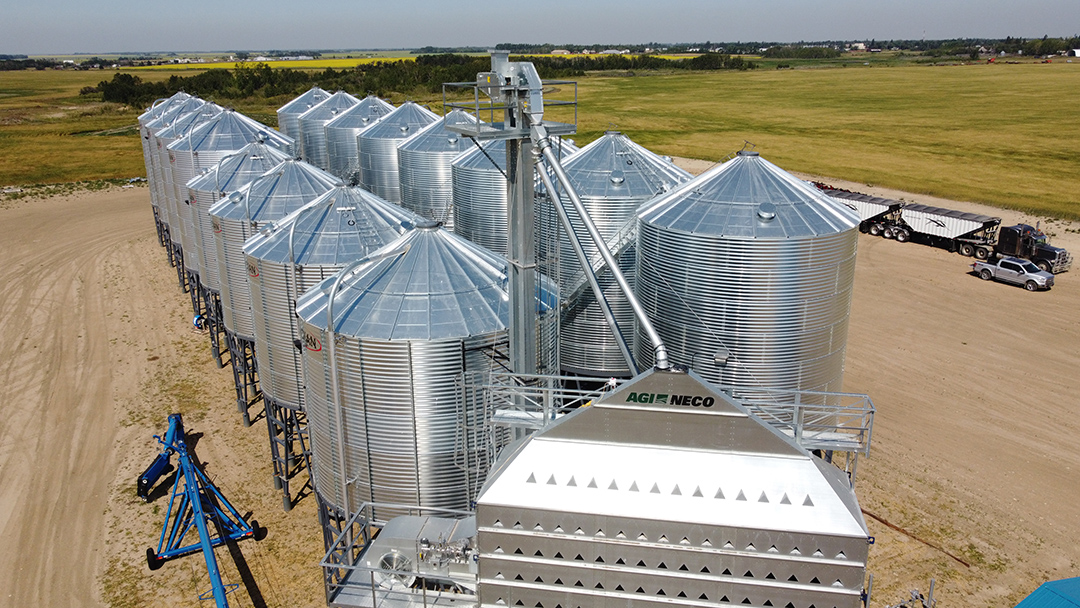
.JPG)



